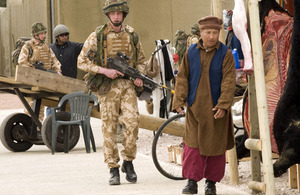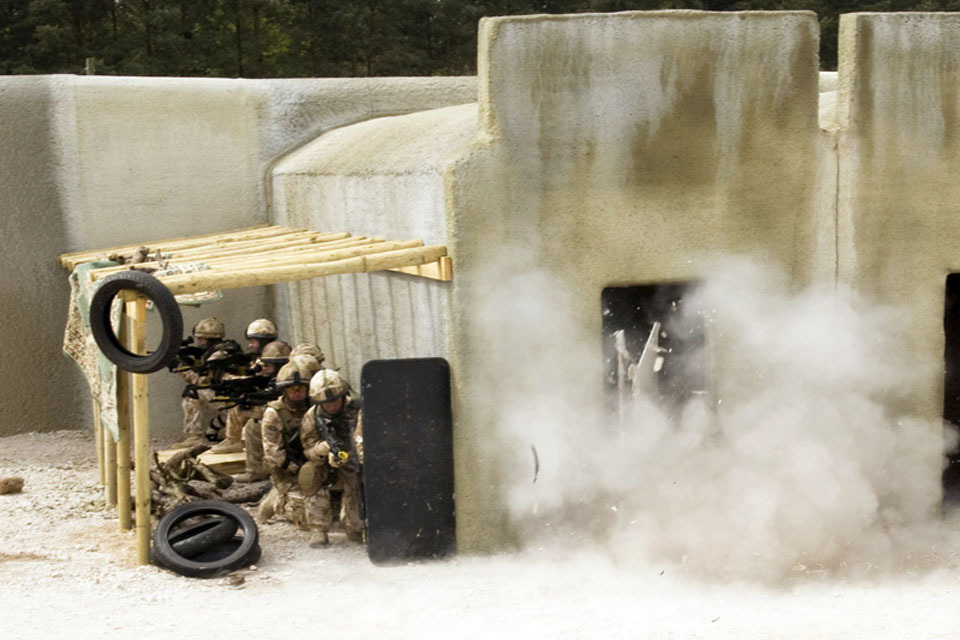Troops train in the Middle East of England
Troops from 1st Battalion The Rifles have been going through the final stages of their pre-deployment training for their upcoming deployment to Helmand at the mock Afghan village at the Stanford Training Area (STANTA) in Norfolk.

A soldier passes a 'local' in the realistic market place of the mock Afghan village at the Stanford Training Area (stock image) [Picture: Andy Cargill ABIPP, Crown Copyright/MOD 2009]
The troops are due to deploy in March 2011 with 3 Commando Brigade Royal Marines. They carried out a number of exercises last week in the bespoke training facility which includes a rural village, an urban complex, and patrol and forward operating bases, all of which were designed by the Operational Training Advisory Group (OPTAG) to replicate, as closely as possible, the situations which troops will encounter in Helmand.
Training at STANTA is the first chance that each battle unit gets to piece together all the various training they have received over the last 12 months, using all the elements that they will have at their disposal in Afghanistan, such as ISTAR (Intelligence, Surveillance, Target Acquisition and Reconnaissance), counter-insurgency techniques and working in partnership with Afghan National Security Forces (ANSF).
To make it all seem even more real, Afghan civilians play the part of locals in the villages.
Major Marcus Luckyn-Malone, OPTAG Formation and Unit Training Advisor for 3 Commando Brigade Royal Marines, said:
We have six days to take the Battle Group through this experience. There are four scenarios which build up layers of complexity and which are all linked. So, if they get it right, they will see a big picture emerging and will connect all the intelligence that is there for them to find.
One of the scenarios takes place in Ishmaragh village, a community in which the locals have broadly accepted local governance and are supportive of ISAF and ANSF troops.
Captain Rob Douglas, one of the scenario organisers, explains the situation the troops are dealing with:
An IED went off this morning. There are two casualties who have just been flown off to Camp Bastion. The ANSF and 3 Commando commanding officers are now meeting to prepare a joint agenda for a shura this afternoon, and will be working out key messages.
A key issue that the commanding officers will have to address is bringing reassurance to the locals who are distressed by the morning’s events.
Inside the village an Afghan world awaits the patrolling troops. Locals are wandering around shouting and a man is chopping wood for a fire burning in a brazier while shopkeepers are trying to attract customers.

A compound clearance is simulated at the Stanford Training Area (stock image) [Picture: Andy Cargill ABIPP, Crown Copyright/MOD 2009]
One young soldier is attracting some unwanted attention. A local is showing a lot of interest in his SA80 rifle. You don’t need to speak Pashto to know he is asking if he can ‘have a go’.
Although the expression on the soldier’s face says ‘please leave me alone’, he keeps his cool, eventually firmly but calmly pushing the local away and carrying on with his patrol.
Further on, in a patrol base, Lance Corporal Neil Wishart has spent his morning defending the base:
This morning has been quiet for us, we are out of the way, but yesterday we conducted a vehicle search,” he said. “I’ve not been to Afghanistan before, but the guys who have tell me that STANTA gives you a good idea of what to expect.
Earlier that morning, at 0300hrs, he was on patrol keeping a look out for narcotics:
There were a few locals cutting about, sitting around the fire and such.
He doesn’t know it yet, but in the compound behind him there is a narcotics and IED-making factory waiting to be discovered, with an added surprise. Captain Douglas lifts up a heavy trapdoor hidden under straw. It opens up to reveal a tunnel:
It’s a rat-run to the next compound. When the patrol comes in our insurgents will duck down here and scarper. We want to test the integrity of the cordon,” he said.
Captain David Robertson served on Operation HERRICK in 2008 and has been through the STANTA training before. He said:
There is a phenomenal amount of training now before we deploy, and this is excellent. We have real amputees playing casualties. That’s really good for the guys, it gets them as prepared as you can be should the worst happen.
Having real Afghans to deal with makes such a difference. There can be a bit of rabbit-in-the-headlights for eighteen-year-old troops who have never left their home towns before.
Meanwhile in a shura, the village elder is putting the commanding officer through his paces:
You have to be friendly to the people so they will trust you; if you come into our compound like you did this morning without asking they think you are attacking,” said the elder.
The commanding officer listens and gives his personal assurances, explaining that having the locals’ co-operation is of paramount importance.
At another location, in the Green Zone (an area of thick vegetation, difficult to fight through, and easy to become disorientated in), A Company, 1st Battalion The Rifles, have been having a hard time. They left at 0930hrs with the task of fighting their way through to a small village to clear it of insurgents and bring reassurance to the inhabitants.
They have been fighting for nearly three-and-a-half hours now and have only made 300 metres progress, and they have already had to call in a Sea King helicopter to extract two casualties.
Colour Sergeant Mark Lambert, one of the OPTAG directing staff, is impressed though. He said:
We have given them a hard time and the terrain is making things very difficult for them. When they entered the village they had the ANA [Afghan National Army] lead the way in so the locals could see it was an Afghan-led operation.
They are keeping their professional calm:
Only engage if you can PID [positively identify],” bellows the company commander.
He is shouting a continuous string of orders, and the troops are responding well. But their day is going to get even harder as they are hit again.
Captain Raymond Dalzell, the lead OPTAG planner who organises all the battle runs, said:
In this case they are chasing down around 15 insurgents. They know more or less where they are. But they have to judge whether it’s a good place to hunt them down, they have to be aware of the village in the background, and on top of that, if they can, as they fall back, the insurgents will be laying IEDs. They have to decide whether to adopt attack or search mode.
All of which distils the ethos of OPTAG training in general and STANTA training in particular, to ‘train as you fight’ is the mantra.
Spokesman on Afghanistan issues, Major General John Lorimer, spent the day with the troops, and was impressed:
It is essential that we prepare our troops to the best of our ability before they deploy and STANTA is hugely important in doing that,” he said.
I have been coming here since I deployed with my brigade to Afghanistan in 2007. Every time I visit I learn something new and see fresh developments.